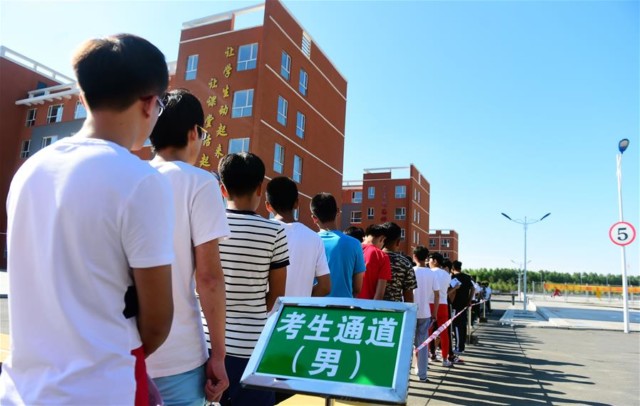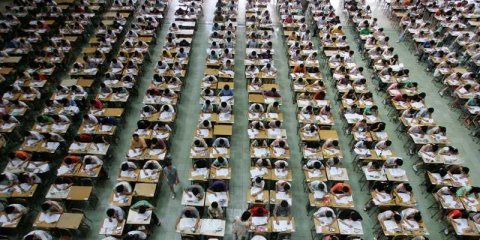After passing through multiple checkpoints, including facial recognition, fingerprint verification and a metal detector, some 9.4 million Chinese students began to sit for the 2016 national college entrance exam on Tuesday.
The test lasts for two or three days depending on the region.
Known as gaokao in Chinese or “college test”, this exam pits students against each other for enrollment at top universities such as Tsinghua University and Peking University.
Many parents who wait outside the exam sites expressed their support and their highest wishes for their children.
Try your luck at some gaokao questions from last year:
[WpProQuiz 5]
“The road is still far. The exam can not decide everything. During the growing process, he must experience such a process as gaokao, and then will have a new understanding of life,” said one parent that did not give a name.
Famed physicist Stephen Hawking even delivered a message to test takers in China on his Weibo page:
”
As many of you prepare to take the National Higher Education Entrance Examination, I want to wish you, the next generation of scientific minds, success in your academic endeavors. This culmination of your hard work marks just the beginning of your very bright futures,” Hawking wrote.
Can U pass China's college entrance exam? Try it: finish 800-word essay in 45 mins, with no more info but this pic pic.twitter.com/kuEg5Zii5z
— China Xinhua News (@XHNews) June 7, 2016
“Growing up, my parents placed a high value on education and I am grateful for the limitless opportunities provided by my studies. Whether you aim to be a doctor, teacher, scientist, musician, engineer, or a writer — be fearless in the pursuit of your aspirations. You are the next generation of big thinkers and thought leaders that will shape the future for generations to come.”
Chinese authorities are imposing strict measures to prevent cheating in this year’s exams, and those who cheat could get three to seven years in prison.
In south China’s Guangxi Zhuang Autonomous Region, authorities for the national examination affairs have detailed rules to supervise every step in the process to ensure test papers to reach students safely.
#ChinaQuiz Wanna try, math nerds? It's one of the easiest questions in China's college entrance exam today pic.twitter.com/Jag8zI5tV3
— China Xinhua News (@XHNews) June 7, 2016
“We have rigid regulations on every step of the process, from test papers’ printing, distribution, transport, custody to final use. The entire process is fully monitored,” Tu Didong, director of the higher education institutions enrollment of Guangxi Entrance Examination Agency said.
Once the test papers are loaded, the carriages will be sealed and double locked. In addition, there will be escort teams in the transport vehicles to ensure the papers to arrive at designated locations timely and safely.
The authorities will also launch a 24-hour monitoring system in each examination room.
In Shijiazhuang, capital of north China’s Hebei province, authorities have a three-layered radio monitoring network to combat exam cheating.
In light of the widely reported “gaokao” fraud scandal last year, east China’s Jiangxi province has taken stringent countermeasures to crack down on exam cheating including pre-exam physical checkups, increased supervision of exam rooms, and more training and qualification evaluations.
Test papers will also be sent from printing houses directly to exam locations ward off leaks.
The number of students sitting for the exam is 20,000 fewer than last year, as an thousands of Chinese students have chosen to study abroad or have been granted early admission at universities.
Story by CCTV+ and CCTV America
 CGTN America
CGTN America Candidates queue to enter an exam site of the national college entrance exam at the No. 3 Middle School in Nong’an County, northeast China’s Jilin Province, June 7, 2016. (Xinhua/Lin Hong)
Candidates queue to enter an exam site of the national college entrance exam at the No. 3 Middle School in Nong’an County, northeast China’s Jilin Province, June 7, 2016. (Xinhua/Lin Hong)

